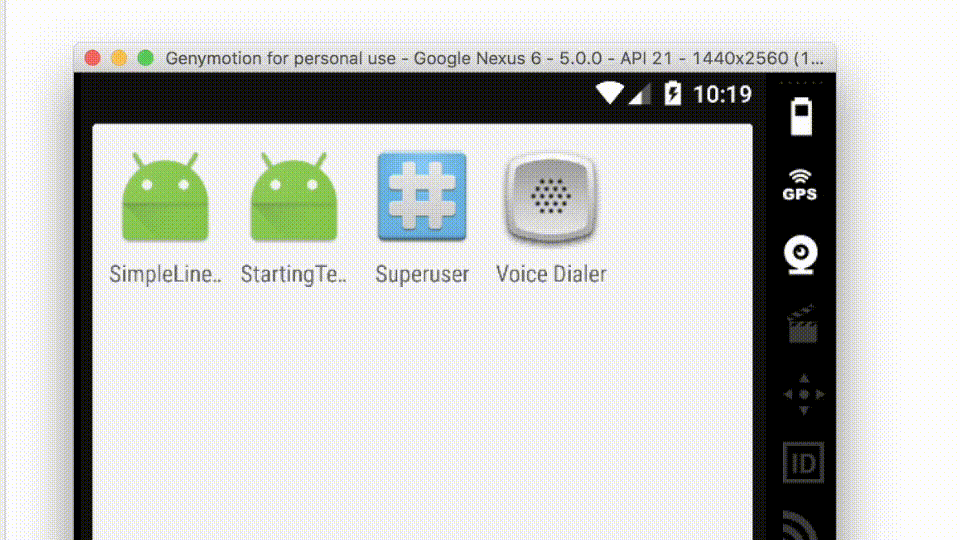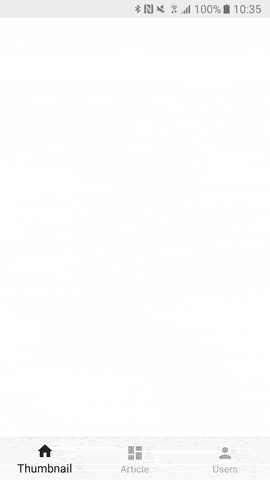Progress bar while loading image using Glide
AndroidAndroid GlideAndroid Problem Overview
Can I load a spinner in placeholder with rotating animation until the image is loaded using Glide?
I am trying to do that using .placeholder(R.Drawable.spinner) no animation is coming up?
It would be great if somebody could help me out?
Thanks!
Android Solutions
Solution 1 - Android
Edit: This is super simple now with the CircularProgressDrawable
build.gradle
implementation "androidx.swiperefreshlayout:swiperefreshlayout:1.1.0"
MyGlideModule.kt
@GlideModule
class MyGlideModule : AppGlideModule()
MainActivity.kt
override fun onCreate(savedInstanceState: Bundle?) {
super.onCreate(savedInstanceState)
setContentView(R.layout.activity_main)
val circularProgressDrawable = CircularProgressDrawable(this)
circularProgressDrawable.strokeWidth = 5f
circularProgressDrawable.centerRadius = 30f
circularProgressDrawable.start()
GlideApp.with(applicationContext)
.load("https://raw.githubusercontent.com/bumptech/glide/master/static/glide_logo.png")
.placeholder(circularProgressDrawable)
.into(a_main_image)
}
These are some other Glide snippets
Old answer: You could also create a normal ProgressBar, and then hide it on Glide's onResourceReady().
> The method that will be called when the resource load has finished.
Example:
MainActivity.java
@Override
protected void onCreate(Bundle savedInstanceState) {
super.onCreate(savedInstanceState);
setContentView(R.layout.activity_main);
final ImageView imageView = (ImageView) findViewById(R.id.img_glide);
final ProgressBar progressBar = (ProgressBar) findViewById(R.id.progress);
Glide.with(this)
.load("https://raw.githubusercontent.com/bumptech/glide/master/static/glide_logo.png")
.listener(new RequestListener<Drawable>() {
@Override
public boolean onLoadFailed(@Nullable GlideException e, Object model, Target<Drawable> target, boolean isFirstResource) {
progressBar.setVisibility(View.GONE);
return false;
}
@Override
public boolean onResourceReady(Drawable resource, Object model, Target<Drawable> target, DataSource dataSource, boolean isFirstResource) {
progressBar.setVisibility(View.GONE);
return false;
}
})
.into(imageView);
}
activity_main.xml (layout):
<?xml version="1.0" encoding="utf-8"?>
<RelativeLayout xmlns:android="http://schemas.android.com/apk/res/android"
xmlns:tools="http://schemas.android.com/tools"
android:layout_width="match_parent"
android:layout_height="match_parent"
tools:context=".MainActivity">
<ProgressBar
android:id="@+id/progress"
android:layout_width="match_parent"
android:layout_height="100dp"
android:visibility="visible" />
<ImageView
android:id="@+id/img_glide"
android:layout_width="match_parent"
android:layout_height="100dp" />
</RelativeLayout>
Result:
Solution 2 - Android
You can set progress value whatever you want with my GlideImageLoader.
I hope it will solve your question.
I encapsulate Image loader with progress in GlideImageLoader.java & ProgressAppGlideModule .java
How to implement with 3 steps:
1. build.gradle
//Glide
implementation 'com.github.bumptech.glide:glide:4.4.0'
annotationProcessor 'com.github.bumptech.glide:compiler:4.4.0'
implementation 'com.github.bumptech.glide:okhttp3-integration:4.4.0'
2. Clone GlideImageLoader.java & ProgressAppGlideModule.Java into Your Project
3. Simple Use anywhere
RequestOptions options = new RequestOptions()
.centerCrop()
.placeholder(R.drawable.placeholder)
.error(R.drawable.ic_pic_error)
.priority(Priority.HIGH);
new GlideImageLoader(YOUR.imageView,
YOUR.progressBar).load(url,options);
Complete Java code for clone:
GlideImageLoader.java
public class GlideImageLoader {
private ImageView mImageView;
private ProgressBar mProgressBar;
public GlideImageLoader(ImageView imageView, ProgressBar progressBar) {
mImageView = imageView;
mProgressBar = progressBar;
}
public void load(final String url, RequestOptions options) {
if (url == null || options == null) return;
onConnecting();
//set Listener & start
ProgressAppGlideModule.expect(url, new ProgressAppGlideModule.UIonProgressListener() {
@Override
public void onProgress(long bytesRead, long expectedLength) {
if (mProgressBar != null) {
mProgressBar.setProgress((int) (100 * bytesRead / expectedLength));
}
}
@Override
public float getGranualityPercentage() {
return 1.0f;
}
});
//Get Image
Glide.with(mImageView.getContext())
.load(url)
.transition(withCrossFade())
.apply(options.skipMemoryCache(true))
.listener(new RequestListener<Drawable>() {
@Override
public boolean onLoadFailed(@Nullable GlideException e, Object model, Target<Drawable> target, boolean isFirstResource) {
ProgressAppGlideModule.forget(url);
onFinished();
return false;
}
@Override
public boolean onResourceReady(Drawable resource, Object model, Target<Drawable> target, DataSource dataSource, boolean isFirstResource) {
ProgressAppGlideModule.forget(url);
onFinished();
return false;
}
})
.into(mImageView);
}
private void onConnecting() {
if (mProgressBar != null) mProgressBar.setVisibility(View.VISIBLE);
}
private void onFinished() {
if (mProgressBar != null && mImageView != null) {
mProgressBar.setVisibility(View.GONE);
mImageView.setVisibility(View.VISIBLE);
}
}
}
ProgressAppGlideModule.java
@GlideModule
public class ProgressAppGlideModule extends AppGlideModule {
@Override
public void registerComponents(Context context, Glide glide, Registry registry) {
super.registerComponents(context, glide, registry);
OkHttpClient client = new OkHttpClient.Builder()
.addNetworkInterceptor(new Interceptor() {
@Override
public Response intercept(Chain chain) throws IOException {
Request request = chain.request();
Response response = chain.proceed(request);
ResponseProgressListener listener = new DispatchingProgressListener();
return response.newBuilder()
.body(new OkHttpProgressResponseBody(request.url(), response.body(), listener))
.build();
}
})
.build();
registry.replace(GlideUrl.class, InputStream.class, new OkHttpUrlLoader.Factory(client));
}
public static void forget(String url) {
ProgressAppGlideModule.DispatchingProgressListener.forget(url);
}
public static void expect(String url, ProgressAppGlideModule.UIonProgressListener listener) {
ProgressAppGlideModule.DispatchingProgressListener.expect(url, listener);
}
private interface ResponseProgressListener {
void update(HttpUrl url, long bytesRead, long contentLength);
}
public interface UIonProgressListener {
void onProgress(long bytesRead, long expectedLength);
/**
* Control how often the listener needs an update. 0% and 100% will always be dispatched.
* @return in percentage (0.2 = call {@link #onProgress} around every 0.2 percent of progress)
*/
float getGranualityPercentage();
}
private static class DispatchingProgressListener implements ProgressAppGlideModule.ResponseProgressListener {
private static final Map<String, UIonProgressListener> LISTENERS = new HashMap<>();
private static final Map<String, Long> PROGRESSES = new HashMap<>();
private final Handler handler;
DispatchingProgressListener() {
this.handler = new Handler(Looper.getMainLooper());
}
static void forget(String url) {
LISTENERS.remove(url);
PROGRESSES.remove(url);
}
static void expect(String url, UIonProgressListener listener) {
LISTENERS.put(url, listener);
}
@Override
public void update(HttpUrl url, final long bytesRead, final long contentLength) {
//System.out.printf("%s: %d/%d = %.2f%%%n", url, bytesRead, contentLength, (100f * bytesRead) / contentLength);
String key = url.toString();
final UIonProgressListener listener = LISTENERS.get(key);
if (listener == null) {
return;
}
if (contentLength <= bytesRead) {
forget(key);
}
if (needsDispatch(key, bytesRead, contentLength, listener.getGranualityPercentage())) {
handler.post(new Runnable() {
@Override
public void run() {
listener.onProgress(bytesRead, contentLength);
}
});
}
}
private boolean needsDispatch(String key, long current, long total, float granularity) {
if (granularity == 0 || current == 0 || total == current) {
return true;
}
float percent = 100f * current / total;
long currentProgress = (long) (percent / granularity);
Long lastProgress = PROGRESSES.get(key);
if (lastProgress == null || currentProgress != lastProgress) {
PROGRESSES.put(key, currentProgress);
return true;
} else {
return false;
}
}
}
private static class OkHttpProgressResponseBody extends ResponseBody {
private final HttpUrl url;
private final ResponseBody responseBody;
private final ResponseProgressListener progressListener;
private BufferedSource bufferedSource;
OkHttpProgressResponseBody(HttpUrl url, ResponseBody responseBody,
ResponseProgressListener progressListener) {
this.url = url;
this.responseBody = responseBody;
this.progressListener = progressListener;
}
@Override
public MediaType contentType() {
return responseBody.contentType();
}
@Override
public long contentLength() {
return responseBody.contentLength();
}
@Override
public BufferedSource source() {
if (bufferedSource == null) {
bufferedSource = Okio.buffer(source(responseBody.source()));
}
return bufferedSource;
}
private Source source(Source source) {
return new ForwardingSource(source) {
long totalBytesRead = 0L;
@Override
public long read(Buffer sink, long byteCount) throws IOException {
long bytesRead = super.read(sink, byteCount);
long fullLength = responseBody.contentLength();
if (bytesRead == -1) { // this source is exhausted
totalBytesRead = fullLength;
} else {
totalBytesRead += bytesRead;
}
progressListener.update(url, totalBytesRead, fullLength);
return bytesRead;
}
};
}
}
}
Solution 3 - Android
I was writing an app in Kotlin and was having this exact problem, but, unfortunately, the accepted answer was in Java. So, I rewrote it in Kotlin.
Glide.with(context)
.load("<Insert Your URL>")
.listener(object : RequestListener<Drawable> {
override fun onResourceReady(resource: Drawable?, model: Any?, target: Target<Drawable>?, dataSource: DataSource?, isFirstResource: Boolean): Boolean {
progressBar.visibility = View.GONE
return false
}
override fun onLoadFailed(e: GlideException?, model: Any?, target: Target<Drawable>?, isFirstResource: Boolean): Boolean {
progressBar.visibility = View.GONE
return false
}
})
.into(holder.imageView)
Solution 4 - Android
Yes we can show loader on ImageView using Glide RequestOptions.
1)Use below compile line in app level gradle file.
implementation 'com.github.bumptech.glide:glide:4.8.0' annotationProcessor 'com.github.bumptech.glide:compiler:4.8.0'
2)Add progress_animation.xml file in drawable
<?xml version="1.0" encoding="utf-8"?>
<animated-rotate xmlns:android="http://schemas.android.com/apk/res/android"
android:drawable="@drawable/loader_test"
android:pivotX="50%"
android:pivotY="50%"/>
3)Add below loader_test.png image in drawable

4)Create RequestOption as below
public RequestOptions options = new RequestOptions()
.centerCrop()
.placeholder(R.drawable.progress_animation)
.error(R.drawable.user_image)
.diskCacheStrategy(DiskCacheStrategy.ALL)
.priority(Priority.HIGH)
.dontAnimate()
.dontTransform();
5)Finally use this to load image as below
Glide.with(this).load(//*Your image url*//).apply(options).into(image_view);
Solution 5 - Android
Here is my complete solution with a circle loading progress. I think it is better to use requestOptionsattributes to achieve this.
CircularProgressDrawable circularProgressDrawable = new CircularProgressDrawable(context);
circularProgressDrawable.setStrokeWidth(5f);
circularProgressDrawable.setCenterRadius(30f);
circularProgressDrawable.start();
RequestOptions requestOptions = new RequestOptions();
requestOptions.placeholder(circularProgressDrawable);
requestOptions.error(R.drawable.ic_image_not_found);
requestOptions.skipMemoryCache(true);
requestOptions.fitCenter();
glide.load(imagePath) //passing your url to load image.
.load(imagePath)
.apply(requestOptions) // here you have all options you need
.transition(DrawableTransitionOptions.withCrossFade()) // when image (url) will be loaded by glide then this face in animation help to replace url image in the place of placeHolder (default) image.
.listener(requestListener)
.into(view); //pass imageView reference to appear the image.
And you got it.
Solution 6 - Android
Another trick: Put your ImageView inside a RelativeLayout with a ProgressBar behind it. Then load the image via Glide or Picasso. It will do the job for you without any deep digging. You don't need to hide or show the progressbar anymore. It will be fully overlapped by the image.
<RelativeLayout
android:layout_width="match_parent"
android:layout_height="@dimen/_180sdp">
<ProgressBar
android:layout_centerInParent="true"
android:layout_width="wrap_content"
android:layout_height="wrap_content"/>
<ImageView
android:id="@+id/iv_image"
android:layout_width="match_parent"
android:layout_height="@dimen/_180sdp"
android:scaleType="centerCrop"/>
</RelativeLayout>
Solution 7 - Android
Try using RequestOptions
RequestOptions requestOptions = new RequestOptions();
requestOptions.placeholder(R.drawable.ic_placeholder);
requestOptions.error(R.drawable.ic_error);
Glide.with(MainActivity.this)
.load(url)
.apply(requestOptions)
.into(imageview);
This is the one way you can implement loading image using with Glide.
Solution 8 - Android
Step -1 create drawable as progress_animation.xml
<?xml version="1.0" encoding="utf-8"?>
<animated-rotate xmlns:android="http://schemas.android.com/apk/res/android"
android:drawable="@drawable/loader_test"
android:pivotX="50%"
android:pivotY="50%"/>
step 2 download loader_test and save in drawable.
step 3 for animate loading
step 4 in case of error user can set error image in error
Glide.with(this).load(url).apply(
RequestOptions().placeholder(R.drawable.progress_animation).error((R.drawable.ic_account)).centerCrop()
.diskCacheStrategy(DiskCacheStrategy.ALL)
.priority(Priority.HIGH)
.transform(CenterCrop(), RoundedCorners(1000)))
.into(image_view)

